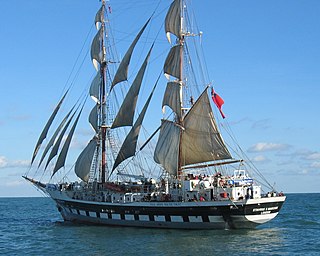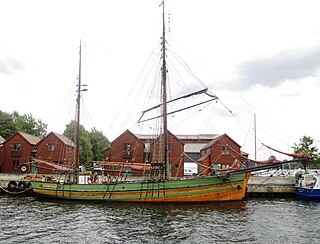
A barquentine or schooner barque is a sailing vessel with three or more masts; with a square rigged foremast and fore-and-aft rigged main, mizzen and any other masts.

Stavros S Niarchos is a British brig-rigged tall ship, now renamed "Sunset". She was previously owned and operated by the Tall Ships Youth Trust (TSYT). She was primarily designed to provide young people with the opportunity to undertake voyages as character-building exercises, rather than pure sail-training. She was also used for adult voyages and holidays, which helped subsidise the operation of the ship.

From its modern interpretations to its antecedents when maritime nations would send young naval officer candidates to sea, sail training provides an unconventional and effective way of building many useful skills on and off the water.

Iron-hulled sailing ships represented the final evolution of sailing ships at the end of the age of sail. They were built to carry bulk cargo for long distances in the nineteenth and early twentieth centuries. They were the largest of merchant sailing ships, with three to five masts and square sails, as well as other sail plans. They carried lumber, guano, grain or ore between continents. Later examples had steel hulls. They are sometimes referred to as "windjammers" or "tall ships". Several survive, variously operating as school ships, museum ships, restaurant ships, and cruise ships.

PNS Rah Naward is a sail training ship of the Pakistan Navy. She was commissioned in 2001 as Prince William for the Tall Ships Youth Trust and sold in 2010 to the Pakistan Navy and renamed Rah Naward.

One and All is a tall ship based in Adelaide, and rigged for twelve sails, which are controlled by 100 lines. After being launched in 1985, she took part in the First Fleet Re-enactment Voyage as part of Australia's bicentenary celebrations, travelling from Rio de Janeiro back to Australia. She was commonly used for sail training, offering courses and voyages that last from between a few hours to many weeks, especially for youth at risk. The vessel is run by registered not for profit group Friends of One and All Sailing ship Inc. and supported by volunteers and professional crew.

Jubilee Sailing Trust was a charitable organisation in the United Kingdom which operated the purpose-built three-masted barques STS Lord Nelson and SV Tenacious, both specifically designed for the physically handicapped to be able to fully engage with the sailing experience.

INS Tarangini is a three-masted barque, commissioned in 1997 as a sail training ship for the Indian Navy. She is square rigged on the fore and main masts and fore-and-aft rigged on the mizzen mast. She was constructed in Goa to a design by the British naval architect Colin Mudie, and launched on 1 December 1995. In 2003–04, she became the first Indian naval ship to circumnavigate the globe.

Picton Castle is a tall ship used for deep-ocean sail training and long distance education voyages. The ship was the subject of the television series Tall Ship Chronicles which documented her second voyage around the world in 2001. The ship has carried out seven world voyages to date - completing the seventh one in 2019. While flagged in the Cook Islands, the ship's unofficial home port is Lunenburg, Nova Scotia.

The STS Leeuwin II is a tall ship based in Fremantle, Western Australia used for sail training for youths.

R. Tucker Thompson is a gaff-rigged topsail schooner based in Opua, Bay of Islands, New Zealand. She is operated as a non-for profit charitable trust and owned by the R. Tucker Thompson Sail Training Trust. The mission of the trust is “Learning for Life through the Sea”. The ship is used for tourism day sails in the Bay of Islands from October through April and for sail training activities between May and September. Youth sail training is particularly focused at youth from the Tai Tokerau Northland region of New Zealand. She is a member of the Australian Sail Training Association (AUSTA), and participated in the American Sail Training Association (ASTA) West Coast Tall Ships Challenge events in 2002 and 2005.

Tradewind is a Dutch topsail schooner. She was built in the Netherlands in 1911 as a herring lugger named Sophie Theresia.

Windeward Bound is a two-masted brigantine-rigged vessel based in Hobart, Tasmania, Australia. The vessel is named after Lewis Winde, the builder of an 1848 Boston schooner on which Windeward Bound was modelled. It is constructed almost entirely of Tasmanian eucalypt, huon pine and Oregon pine, recycled from old boats and buildings. The hull is constructed of 5 cm hardwood strip planks, over epoxy-laminated douglas fir frames, spaced 38 cm apart. The stem, sternpost and keel are of epoxy-laminated Tasmanian blue gum and the decks are of huon and New Zealand kauri pines.

KLD Tunas Samudera is a two-masted schooner, or brigantine, of the Royal Malaysian Navy. Tunas Samudera was built by Brooke Yachts in Lowestoft, United Kingdom. She was laid down in 1988, launched in 1989, and christened by Queen Elizabeth II and the King of Malaysia. Tunas Samudera is a sail training ship with the Royal Malaysian Navy.

The tall ship Spirit of New Zealand is a steel-hulled, three-masted barquentine from Auckland, New Zealand. It was purpose-built by the Spirit of Adventure Trust in 1986 for youth development. It is 42.5 m in total length and carries a maximum of 40 trainees and 14 crew on overnight voyages. The ship's home port is Auckland, and it spends most of its time sailing around the Hauraki Gulf. During the summer season, it often sails to the Marlborough Sounds and Nelson, at the top of the South Island.

HMS Endeavour replica is a replica of HMS Endeavour, the bark commanded by Lieutenant James Cook when he charted New Zealand and the eastern coast of Australia.

Bounty was built in 1977/78 for the movie The Bounty starring Mel Gibson and Anthony Hopkins. The ship launched on 16 December 1978 and was decommissioned in 2017.

Southern Swan is a traditional Baltic trader, currently rigged as a three-masted barquentine. She is typical of coastal trading ships from the era 1840s to 1940s.

Anna Kristina is a Norwegian-flagged, galeas-rigged Hardangerjakt. Originally named Dyrafjeld, the sloop-rigged vessel was built on a Norwegian farm in 1889. The ship's early career was as a cargo ship in the Hardanger region, with occasional voyages as far afield as Russia. She was sold to new owners and rerigged as a galeas in the late 1920s. The sails were removed during World War II, but continued in merchant service until the mid-1970s. After a series of accidents, the vessel was laid up, then sold to new owners, who restored the vessel and renamed her Anna Kristina. Charter work occurred throughout the 1980s, including involvement in the First Fleet Re-enactment Voyage.
Colin Mudie was an Edinburgh-born yacht designer, author, naval historian, balloonist, and advocate for the handicapped sailor. He studied engineering at Southampton University, before working under yacht designers including Laurent Giles and Uffa Fox. He then set up his own firm. He received the award of RDI for Small craft/ naval in 1995.






















